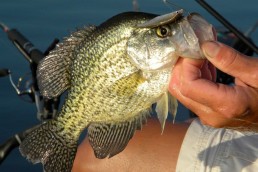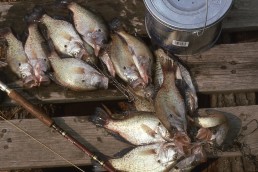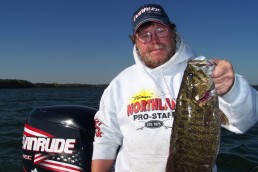Celebrate the Season, get out there and Catch Crappies
SHARE THIS POST
Writing about methods to catch fish is always fun, and there are many techniques that work on a variety of lakes.
Are you enjoying this post?
You can be among the first to get the latest info on where to go, what to use and how to use it!
This time of year we all are very excited to see family members who are usually away at school and at home visiting or those who live in different states. Many people over the years may have purchased a second home, which is used during summer and the winter holiday season or are simply enjoying coming up to the Northwoods of Wisconsin for a few days at a time.
When venturing out to these destinations during summer, and catching a few fish, we like to set up a time to return in the winter and catch more fish and enjoy a great fish fry. The crappies can be just as good during the winter as summertime, and even more exciting.
Looking for the exact spots where we caught them during summer is a start, but this may not work during winter, as the crappies may have moved to different feeding areas inside the lake.
Inside a deep, clear lake we may catch crappies on the bottom or very close to in a couple of locations, deep-wood piles or deep ledges around the main lake basin, using very small minnows for bait. The water temperatures are very cold, but can be 10 degrees warmer at the bottom of a lake. (The bottom of the lake is much warmer than the water just below the ice in all lakes.)
During winter, we do not move the bait with our rods in an aggressive fashion, although you may hear stories how other people do move the bait aggressively—we do not. Some crappie fishermen use a device called a Tip-Down. This device holds a small rod and reel in place in a motionless vertical position, and when the fish bites, the delicately balanced device will dip the rod downward indicating a strike. Do we need to be this transparent? No, but moving the bait in a subtle motion after an aggressive motion—to create interest—produces more strikes once the crappies
have been located.
Now, when fishing for crappies in other environments people like using a clip with a very small chain connected in conjunction with a lure connected to the chain. This produces fish for them. Also, depending on the lake you are fishing, tiny minnows work best. We like 2-pound-test mono tied directly to a small ice jig with a small minnow or colored waxworm (and yes, a natural-colored wax-worm produces well). The colored waxworm works in stained water conditions or heavily fished areas and there are several different colors available. Ordering online is best.Also, use light line, small ice jigs and artificials as well as live bait.
Have you heard of Rosy Reds, a small minnow (1 inch long) that looks like a miniature goldfish? They work, and if they are legal in your area, use them, they work very well.
Now, where do we go to catch crappies? Well, it’s not as hard as it seems. As described above, we need to do some homework. This may start in late fall or in winter at locations where you have caught them. Start with your late-fall locations; they won’t be too far away a few weeks later as ice-up takes over.
Did you ever notice when cleaning your crappies for the frying pan what they had in their stomachs? I have. Sometimes, there’s nothing at all, sometimes there’s small larvae in there stomach, and then depending on your lake, there are tiny 3/4-inch perch in there. Or, there could be other types of minnows or other aquatic insects.
John Andrew is the owner operator of The Anglers Choice Guide Service located in northern Wisconsin and he can be reached at 715-892-3020, 715-686-2012 or johnandrew@centurytel.net or theanglerschoiceguideservice.com.
MWO
SHARE THIS POST
Did you enjoy this post?
You can be among the first to get the latest info on where to go, what to use and how to use it!
John Andrew
John Andrew is the owner/operator of The Anglers Choice Guide Service located in northern Wisconsin. He may be reached at 715-892-3020, 715-686-2012 or johnandrew@centurytel.net or theanglerschoiceguideservice.com.




